2017 PEUGEOT 3008 window
[x] Cancel search: windowPage 106 of 566
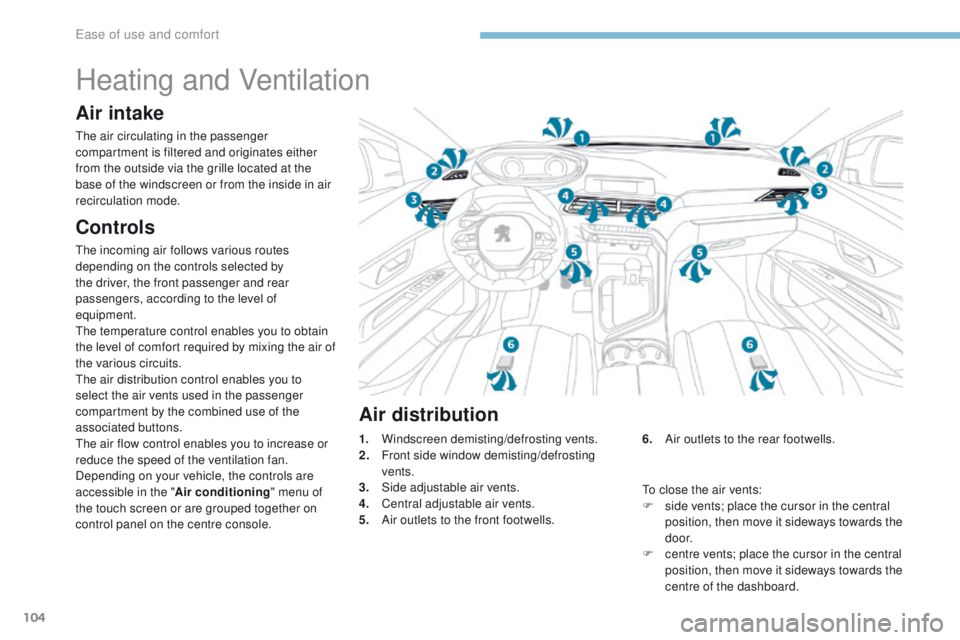
104
3008-2_en_Chap03_ergonomie-et-confort_ed01-2016
Heating and Ventilation
Air intake
The air circulating in the passenger
compartment is filtered and originates either
from the outside via the grille located at the
base of the windscreen or from the inside in air
recirculation mode.
Controls
The incoming air follows various routes
depending on the controls selected by
the driver, the front passenger and rear
passengers, according to the level of
equipment.
The temperature control enables you to obtain
the level of comfort required by mixing the air of
the various circuits.
The air distribution control enables you to
select the air vents used in the passenger
compartment by the combined use of the
associated buttons.
The air flow control enables you to increase or
reduce the speed of the ventilation fan.
Depending on your vehicle, the controls are
accessible in the "Air conditioning" menu of
the touch screen or are grouped together on
control panel on the centre console.
Air distribution
1. Windscreen demisting/defrosting vents.
2. F ront side window demisting/defrosting
vents.
3.
S
ide adjustable air vents.
4.
C
entral adjustable air vents.
5.
A
ir outlets to the front footwells. 6. A
ir outlets to the rear footwells.
To close the air vents:
F
s
ide vents; place the cursor in the central
position, then move it sideways towards the
d o o r.
F
c
entre vents; place the cursor in the central
position, then move it sideways towards the
centre of the dashboard.
Ease of use and comfort
Page 108 of 566
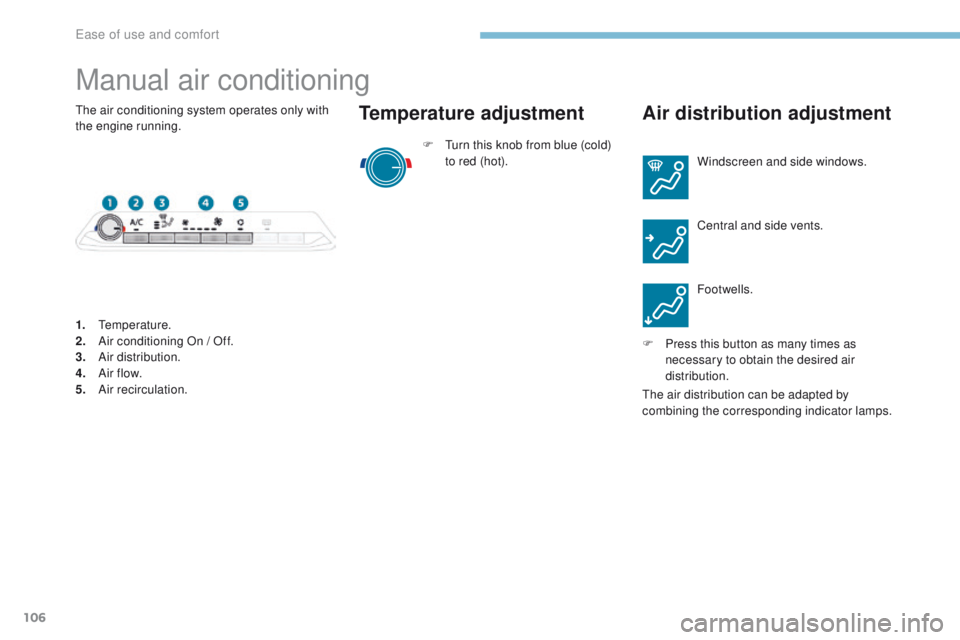
106
3008-2_en_Chap03_ergonomie-et-confort_ed01-2016
Manual air conditioning
F Turn this knob from blue (cold) to red (hot).
Temperature adjustment Air distribution adjustment
Windscreen and side windows.
Central and side vents.
Footwells.
F
P
ress this button as many times as
necessary to obtain the desired air
distribution.
1.
Temperature.
2.
A
ir conditioning On / Off.
3.
A
ir distribution.
4.
A
ir f low.
5.
A
ir recirculation.
The air conditioning system operates only with
the engine running.
The air distribution can be adapted by
combining the corresponding indicator lamps.
Ease of use and comfort
Page 109 of 566
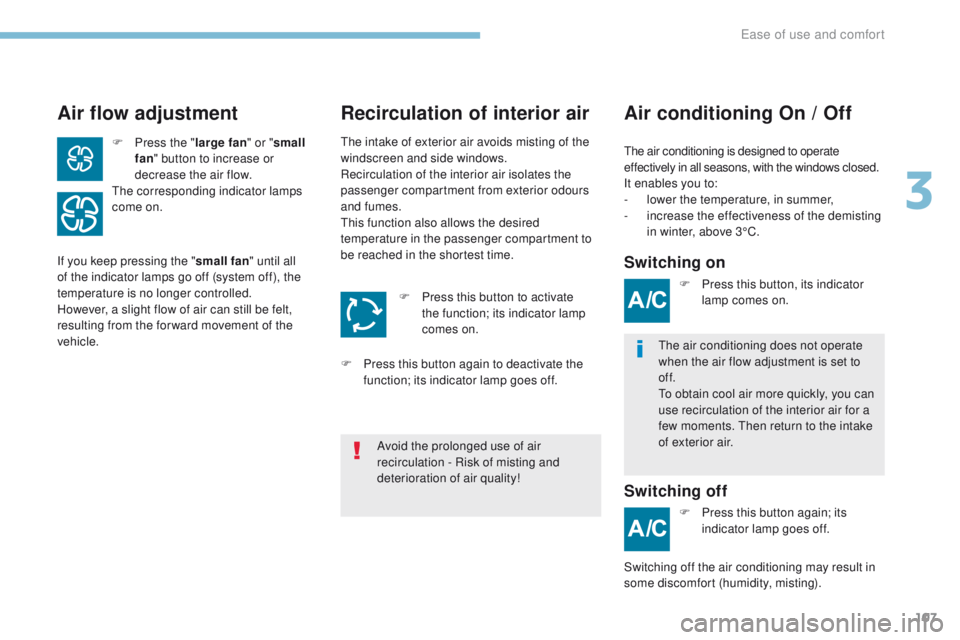
107
3008-2_en_Chap03_ergonomie-et-confort_ed01-2016
Air flow adjustmentAir conditioning On / Off
Recirculation of interior air
The air conditioning is designed to operate
effectively in all seasons, with the windows closed.
It enables you to:
-
l
ower the temperature, in summer,
-
i
ncrease the effectiveness of the demisting
in winter, above 3°C.
F
P
ress this button to activate
the function; its indicator lamp
comes on.
F
P
ress the "
large fan " or "small
fan " button to increase or
decrease the air flow.
The corresponding indicator lamps
come on.
Switching on
Switching off
The air conditioning does not operate
when the air flow adjustment is set to
of f.
To obtain cool air more quickly, you can
use recirculation of the interior air for a
few moments. Then return to the intake
of exterior air.
If you keep pressing the "
small fan" until all
of the indicator lamps go off
(system off), the
temperature is no longer controlled.
However, a slight flow of air can still be felt,
resulting from the for ward movement of the
vehicle.
Avoid the prolonged use of air
recirculation - Risk of misting and
deterioration of air quality!
The intake of exterior air avoids misting of the
windscreen and side windows.
Recirculation of the interior air isolates the
passenger compartment from exterior odours
and fumes.
This function also allows the desired
temperature in the passenger compartment to
be reached in the shortest time.
F
P
ress this button again to deactivate the
function; its indicator lamp goes off.
Switching off the air conditioning may result in
some discomfort (humidity, misting).F
P
ress this button again; its
indicator lamp goes off.
F
P
ress this button, its indicator
lamp comes on.
3
Ease of use and comfort
Page 111 of 566
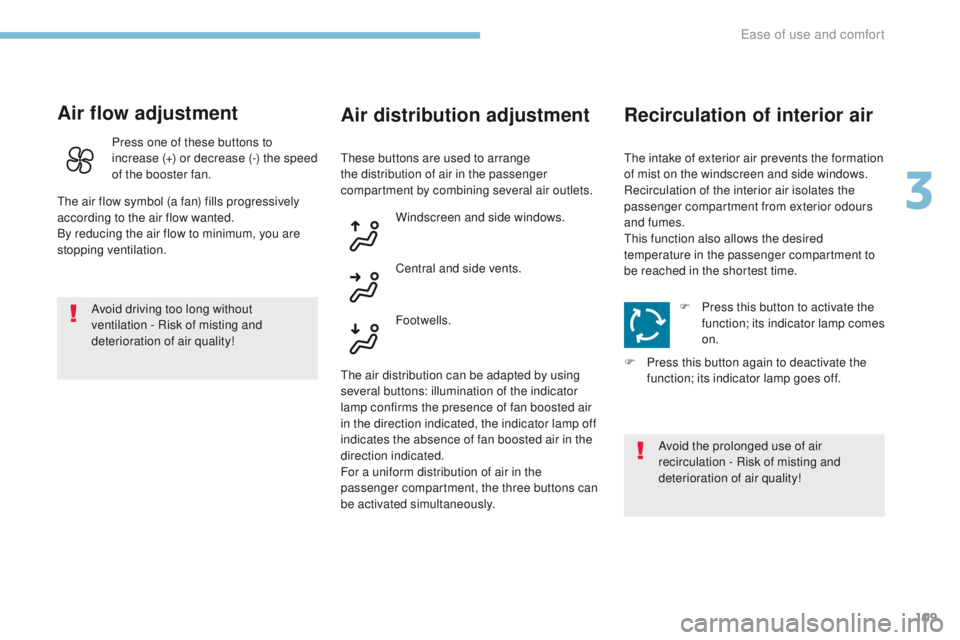
109
3008-2_en_Chap03_ergonomie-et-confort_ed01-2016
Air flow adjustment
Avoid driving too long without
ventilation - Risk of misting and
deterioration of air quality!
Air distribution adjustment Recirculation of interior air
Press one of these buttons to
increase (+) or decrease (-) the speed
of the booster fan.
The air flow symbol (a fan) fills progressively
according to the air flow wanted.
By reducing the air flow to minimum, you are
stopping ventilation. Windscreen and side windows.
Central and side vents.
Footwells.
The air distribution can be adapted by using
several buttons: illumination of the indicator
lamp confirms the presence of fan boosted air
in the direction indicated, the indicator lamp off
indicates the absence of fan boosted air in the
direction indicated.
For a uniform distribution of air in the
passenger compartment, the three buttons can
be activated simultaneously. These buttons are used to arrange
the distribution of air in the passenger
compartment by combining several air outlets.
F
P
ress this button to activate the
function; its indicator lamp comes
on.
F
P
ress this button again to deactivate the
function; its indicator lamp goes off.
Avoid the prolonged use of air
recirculation - Risk of misting and
deterioration of air quality!
The intake of exterior air prevents the formation
of mist on the windscreen and side windows.
Recirculation of the interior air isolates the
passenger compartment from exterior odours
and fumes.
This function also allows the desired
temperature in the passenger compartment to
be reached in the shortest time.
3
Ease of use and comfort
Page 112 of 566
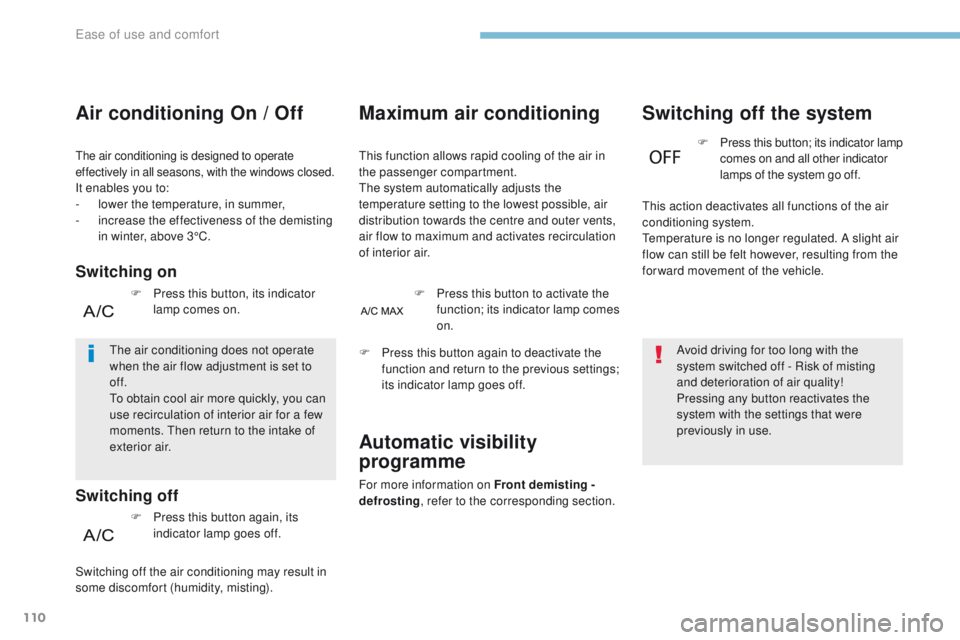
110
3008-2_en_Chap03_ergonomie-et-confort_ed01-2016
Maximum air conditioning
This function allows rapid cooling of the air in
the passenger compartment.
The system automatically adjusts the
temperature setting to the lowest possible, air
distribution towards the centre and outer vents,
air flow to maximum and activates recirculation
of interior air.F
P
ress this button to activate the
function; its indicator lamp comes
on.
Automatic visibility
programme
For more information on Front demisting -
defrosting , refer to the corresponding section.
Air conditioning On / Off
The air conditioning is designed to operate
effectively in all seasons, with the windows closed.
It enables you to:
-
l ower the temperature, in summer,
-
i
ncrease the effectiveness of the demisting
in winter, above 3°C.
Switching on
The air conditioning does not operate
when the air flow adjustment is set to
of f.
To obtain cool air more quickly, you can
use recirculation of interior air for a few
moments. Then return to the intake of
exterior air.
Switching off
Switching off the air conditioning may result in
some discomfort (humidity, misting). F
P
ress this button, its indicator
lamp comes on.
F
P
ress this button again, its
indicator lamp goes off.
Switching off the system
This action deactivates all functions of the air
conditioning system.
Temperature is no longer regulated. A slight air
flow can still be felt however, resulting from the
for ward movement of the vehicle. F
P
ress this button; its indicator lamp
comes on and all other indicator
lamps of the system go off.
Avoid driving for too long with the
system switched off - Risk of misting
and deterioration of air quality!
Pressing any button reactivates the
system with the settings that were
previously in use.
F
P
ress this button again to deactivate the
function and return to the previous settings;
its indicator lamp goes off.
Ease of use and comfort
Page 115 of 566

113
3008-2_en_Chap03_ergonomie-et-confort_ed01-2016
Automatic visibility
programme
For more information on Front demisting /
defrosting, refer to the corresponding section.
"Air Quality System" (AQS)
function
Using a pollution sensor, this function
automatically activates recirculation of the
interior air once it detects a certain level of
polluting substances in the exterior air.
When the air quality returns to a satisfactory
level, recirculation of interior air is automatically
deactivated.
This function is not designed to detect
unpleasant odours.
The function is automatically activated when
the screenwash is used or when in reverse
g e a r.
The function does not operate if the ambient
temperature is below 5°C, to avoid the risk of
misting of the windscreen and side windows.
To activate or deactivate the function, go to the
secondary page by pressing the " OPTIONS"
button. Windscreen and side windows.
Centre and side vents.
Footwells.
Manual control
You can manually adjust one or more settings,
while retaining automatic control of the other
functions:
-
a
ir flow,
-
a
ir distribution.
As soon as you modify a setting, the indicator
lamp in the " AUTO" button goes off.
F
P
ress this button again to
reactivate the automatic comfort
programme.
Air flow adjustment
F Press one of these buttons to increase or decrease the speed
of the booster fan.
The air flow symbol (a fan) is filled in
progressively as the speed of the fan is
increased.
By reducing the air flow to minimum, you are
stopping ventilation.
" OFF " is displayed alongside the fan.
Avoid driving for too long with the
ventilation off - Risk of misting and
deterioration of air quality!
Air distribution adjustment
You can modulate the distribution of air in the
passenger compartment using these three buttons.
Each press on a button activates or deactivates
the function. The indicator lamp is on when the
button is activated. For a uniform distribution in
the passenger compartment, all three buttons
can be pressed simultaneously.
In AUTO mode, the indicator lamps in all three
buttons are off.
3
Ease of use and comfort
Page 116 of 566

114
3008-2_en_Chap03_ergonomie-et-confort_ed01-2016
The air conditioning is designed to operate
efficiently in all seasons, with the windows
closed.
It allows you:
-
i
n summer, to lower the temperature,
-
i
n winter, above 3 °C, to improve demisting.
Air conditioning On / Off
Switching on
Switching off
Maximum air conditioning
F Press this button to activate the function; its indicator lamp comes
on.
F
P
ress this button again to deactivate the
function and return to the previous settings;
its indicator lamp goes off.
This function allows faster cooling of the air in
the passenger compartment.
The system automatically adjusts the
temperature setting to the lowest possible, air
distribution towards the centre and outer vents,
air flow to maximum and activates recirculation
of interior air.
Avoid prolonged operation of the air
recirculation - Risk of misting and of
deterioration of the air quality!
The intake of exterior air avoids misting of the
windscreen and side windows.
Recirculation of the interior
air
Recirculation of interior air prevents exterior
odours and smoke from entering the passenger
compartment.
This function also allows the desired
temperature in the passenger compartment to
be reached in the shortest time.
F
P
ress this button to activate
the function; its indicator lamp
comes on.
F
P
ress this button again to deactivate the
function; its indicator lamp goes off.
F
P
ress this button; its indicator
lamp comes on.
The air conditioning cannot operate
when the air flow is set to off.
F
P
ress this button again; its
indicator lamp goes off.
Switching the air conditioning off may cause
some deterioration of the conditions in the
passenger compartment (humidity, misting).
Ease of use and comfort
Page 118 of 566

116
3008-2_en_Chap03_ergonomie-et-confort_ed01-2016
Front demist - defrost
With semi-automatic and
automatic air conditioning
With Stop & Start, when the demisting,
air conditioning and air flow functions
are activated, STOP mode is not
available.
Automatic visibility programme
With Stop & Start, when demisting has
been activated, the STOP mode is not
available.
The system automatically manages the air
conditioning (depending on version), air
flow and air intake, and provides optimum
distribution towards the windscreen and side
windows.
F
T
o switch it off, press this button; its
indicator lamp goes off.
With manual air
conditioning
F Adjust the temperature to maximum (red).
F A djust the air flow to maximum; all the
indicator lamps come on.
F
A
djust the air distribution to the
" Windscreen" position; its associated
indicator lamp comes on.
F
C
heck that recirculation of interior air is
deactivated; its indicator lamp must be off.
F
S
witch on the air conditioning by pressing
the " A/C" button; its indicator lamp comes
on. F
P
ress this button to demist or
defrost the windscreen and side
windows as quickly as possible;
its indicator lamp comes on.
The system allows the manual modification of
air flow without causing automatic deactivation
of the automatic visibility programme.
Ease of use and comfort